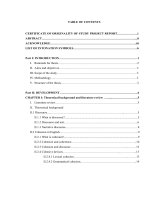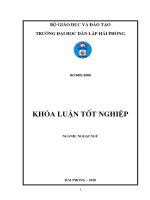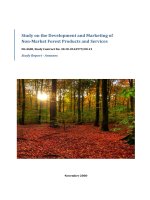Study on critical stages and critical sterility point of thermo-sensitive genic male sterile lines of rice for two line hybrid production
Bạn đang xem bản rút gọn của tài liệu. Xem và tải ngay bản đầy đủ của tài liệu tại đây (476.93 KB, 8 trang )
Int.J.Curr.Microbiol.App.Sci (2017) 6(5): 2128-2135
International Journal of Current Microbiology and Applied Sciences
ISSN: 2319-7706 Volume 6 Number 5 (2017) pp. 2128-2135
Journal homepage:
Original Research Article
/>
Study on Critical Stages and Critical Sterility Point of Thermo-Sensitive
Genic Male Sterile Lines of Rice for Two Line Hybrid Production
K. Sai Rekha1*, M. Kumar2, R. Saraswathi, S. Mannonmani3 and M. Raveendran4
1
Department of Rice, 2Department of Cotton, 3Department of Oilseeds,
4
Centre for Plant Molecular Breeding and Biotechnology,
Tamil Nadu Agricultural University, Coimbatore-003, India
*Corresponding author
ABSTRACT
Keywords
TGMS,
Critical Sterility
Point,
Two line hybrid,
Critical stage,
Critical sterility
temperature
Article Info
Accepted:
19 April 2017
Available Online:
10 May 2017
The genic male sterile rice (GMS) sensitive to temperature during the panicle development
period is a novel type of germplasm in rice, which is sterile under high temperature
condition but fertile in low temperature condition. A number of TGMS lines have been
popularly used in commercial seed production of hybrid rice in China and India. To fix the
duration of critical sterility temperature expression of TGMS lines for hybrid seed
production, eight TGMS lines developed by Department of Rice, Tamil Nadu Agricultural
University were sown in weekly intervals from December 16, 2015 to January 27, 2016.
Heading date and pollen sterility were observed on each line during every planting
interval. The data showed that the critical stage for most of the TGMS lines occurred
during panicle development stages and approximately 26 to 5 days before heading. The
pollen sterility recorded on the plants raised at weekly interval revealed that all lines had
stable sterile phase with 100% pollen sterility for more than 40 consecutive days during
high temperature conditions. TGMS lines TNAU45S, TNAU60S, TNAU95S, GDR 61S
and GDR 70S were identified to have critical sterility point (CSP) at a mean temperature
of above 29˚C. The TGMS lines viz., TNAU45S, TNAU60S, TNAU 95S and GDR61S
were performing stable even during mild changes in temperature and these lines are
considered as stable lines and can be recommended for hybrid seed production. Evaluating
TGMS lines using this new strategy was found to be more stable in terms of sterility
expression and these lines can efficiently used for Two line hybrid production.
Introduction
Rice is the most important cereal of Asia and
is an overwhelming staple food in most
population of this region. It is grown in more
than 100 countries and there are around
18,000 varieties accounting for about 25% of
the World’s food grain production. The green
revolution in many rice producing countries
enabled global rice production to meet the
demands of the World’s increasing
population. However, by 2025, the World
must increase rice production to 880 million
tonnes from the present 560 million tonnes
(FAO). Recent progress in breeding
techniques enables the possibility of
increasing yield through hybrid rice
production.
Currently, CMS system is the most widely
used male sterility system for hybrid rice
production. Although effective, three-line
2128
Int.J.Curr.Microbiol.App.Sci (2017) 6(5): 2128-2135
system of hybrid rice breeding is expensive
and cumbersome. Meanwhile, in three line
system of hybrid rice breeding maintaining
restorer lines for fertility restoration of A line
is a major limiting factor. The two line system
of hybrid breeding utilizing environment
sensitive genic male sterility (EGMS) is better
choice to overcome problems associated with
three line breeding and can increase the rice
global production globally. Tropical countries
like India where more temperature coincides
with most of the days and where day length
differences are marginal, temperature
sensitive genic male sterility (TGMS) system
is considered more useful than the
photoperiod sensitive genic male sterility
(PGMS) system (Virmani, 1996). In order to
exploit this novel male sterility in heterosis
breeding, characterization of new TGMS lines
and finding out critical stages for expression
of sterility and fertility are very essential. In
this context, the present study was taken up to
fix the duration of critical sterility
temperature expression of selected TGMS
lines for hybrid seed production.
Materials and Methods
Eight TGMS lines developed at Tamil Nadu
Agricultural University (TNAU), Coimbatore
and Hybrid Rice Evaluation Centre, Gudalur
through pedigree breeding programme were
taken for evaluation. The lines used in this
experiment are TNAU39S, TNAU45S,
TNAU60S, TNAU95S, GDR 29S, GDR 61S,
GDR 10S and GDR 70S. These lines were
sown in weekly interval from Dec 16, 2015 to
Jan 27, 2016 for seven weeks. These lines
were planted in single row, with 12 plants per
row in spacing of 30x20 cm. Days to first
flowering for each genotype was recorded. At
the heading stage, 5-6 spikelets from primary
panicles from two plants in each line were
collected (Sanchez & Virmani, 2005). The
anthers were crushed and stained with 1%
Iodine- potassium iodide (I-KI) solution.
Pollen sterility was observed under
microscope and was scored using scale
reported by Virmani et al., (1997). These
lines were characterized for their sterility
behaviour and critical stages for two line
hybrid production.
Identifying sterile phase
From the seven sets of data on pollen sterility,
the sterile phase of each TGMS line and the
duration of each phase were identified. The
flowering period, in which the lines were
completely sterile (100% pollen sterility), was
taken as sterile phase. The period in which the
plants recorded more than 50 per cent pollen
fertility was considered as fertile phase. The
period of partial sterility was considered as
the phase of fertility transition (Latha and
Thiyagarajan, 2010).
Relative influence of temperature on
sterility
Data available on maximum temperature,
minimum temperature and mean temperature
from 1-30 days before heading available at
Paddy Breeding Station, Tamil Nadu
Agricultural University (TNAU), Coimbatore
were used. This period corresponds to the
panicle development of rice plant from
differentiation of first bract primordia to
complete formation of spikelets (Virmani &
Sharma 1993).
Critical sterility temperature
The Critical Sterility Temperature (CST) is
the temperature at which the line becomes
sterile from fertile condition. The lowest
mean temperature among the temperatures
inducing sterility was considered as the
critical sterility temperature.
Results and Discussion
The multiplication of TGMS lines and seed
production of two- line hybrids is not a
difficult task as that of 3- line hybrids which
2129
Int.J.Curr.Microbiol.App.Sci (2017) 6(5): 2128-2135
require the additional maintenance of a
maintainer line to multiply sterile line. The
TGMS lines are sensitive to temperature are
even mild fluctuations in temperature leads to
fertility. However, sterile, fertile and fertility
transition phases of TGMS lines need to be
determined so that hybrid seed production on
a larger scale could be possible. The sterility
behaviour of TGMS lines at different dates of
sowing is depicted in Fig 1 to 8.
Among the eight lines, TNAU45S,
TNAU60S,
TNAU95S
and
GDR61S
exhibited 100% sterility in all seven dates of
sowing. The GDR 70S line showed partial
sterility at first date of sowing and TNAU39S
showed partial sterility at first and second
dates of sowing. The GDR 29S showed 100%
sterility at last two dates of sowing in January
and the other line GDR 10S showed 100%
sterility in last four dates of sowing.
Comparing the data among seven staggered
sowings, it is noticed that all lines showed
100% sterility in last two dates of sowing
(21.01.2016 & 27.01.2016). So, these dates of
sowing are recommended for all TGMS lines
for hybrid seed production.
Considering this fact that there is a certain
amount of risk in exploiting rice heterosis by
means of TGMS if temperature fluctuation
occurs at critical stages of panicle
development (Wu, 1997), therefore, idea on
critical stage for alteration in sterility
behaviour is useful to determine the most
suitable time of sowing the TGMS lines for
hybrid seed production. The appropriate
sowing dates of TGMS lines should be
determined in such a way that a critical stage
of panicle development would be exposed to
the required temperature (Latha and
Thiyagarajan, 2010).
Table.1 Days to first flowering, critical stages and critical sterility
points of eight TGMS lines
Lines
Date of sowing
39S
16.12.2015
23.12.2015
30.12.2015
07.01.2016
13.01.2016
21.01.2016
27.01.2016
16.12.2015
23.12.2015
30.12.2015
07.01.2016
13.01.2016
21.01.2016
27.01.2016
16.12.2015
23.12.2015
30.12.2015
07.01.2016
45S
60S
Days to Critical
first
Stage
flowering
85
60-80
85
60-80
85
60-80
85
60-80
84
59-79
85
60-80
85
60-80
105
80-100
105
80-100
105
80-100
106
81-101
104
79-99
104
79-99
103
78-98
95
70-90
100
75-95
98
73-93
100
75-95
2130
Critical Sterility
Temperature
Range
Mean
26.1-29.9
28.28
26.8-31.1
28.95
27.3-31.55
29.61
27.5-31.55
30.18
28.3-31.5
30.59
28.3-32.35
30.73
28.3-32.6
30.91
27.5-31.55
29.97
28.3-31.55
30.59
28.3-32.35
30.68
28.3-32.35
30.91
29.4-32.6
31.26
29.4-32.6
31.57
25.2-32.2
29.97
27.3-31.1
29.25
27.5-31.55
30.18
28.3-31.55
30.58
28.3-32.35
30.8
Sterility %
98
98
100
100
100
100
100
100
100
100
100
100
100
100
100
100
100
100
Int.J.Curr.Microbiol.App.Sci (2017) 6(5): 2128-2135
95S
GDR29S
GDR61S
GDR10S
GDR70S
13.01.2016
21.01.2016
27.01.2016
16.12.2015
23.12.2015
30.12.2015
07.01.2016
13.01.2016
21.01.2016
27.01.2016
16.12.2015
23.12.2015
30.12.2015
07.01.2016
13.01.2016
21.01.2016
27.01.2016
16.12.2015
23.12.2015
30.12.2015
07.01.2016
13.01.2016
21.01.2016
27.01.2016
16.12.2015
23.12.2015
30.12.2015
07.01.2016
13.01.2016
21.01.2016
27.01.2016
16.12.2015
23.12.2015
30.12.2015
07.01.2016
13.01.2016
21.01.2016
27.01.2016
95
95
98
110
110
108
110
106
106
109
99
100
98
101
98
98
102
95
99
98
99
98
98
97
86
85
86
85
86
86
87
105
104
106
105
105
104
105
70-90
70-90
73-93
85-105
85-105
83-103
85-105
81-101
81-101
84-104
74-94
75-95
73-93
76-96
73-93
73-93
77-97
70-90
74-94
73-93
74-94
73-93
73-93
72-92
61-81
60-80
61-81
60-80
61-81
61-81
62-82
80-100
79-99
81-101
80-100
80-100
79-99
80-100
2131
28.3-32.6
29.4-32.6
25.2-32.4
28.3-31.55
28.3-31.55
28.3-32.35
29.4-32.6
29.4-32.6
29.4-32.6
29.4-32.6
27.3-31.3
27.5-31.55
28.3-31.55
28.3-32.6
28.3-32.6
29.4-32.6
25.2-32.2
27.3-31.1
27.5-31.55
28.3-31.55
28.3-32.35
28.3-32.6
29.4-32.6
25.2-32.4
26.1-29.1
26.8-31.1
27.3-31.55
27.5-31.55
28.3-31.55
28.3-32.35
29.4-32.6
27.5-31.55
28.3-31.55
28.3-32.35
28.3-32.6
29.4-32.6
29.4-32.6
29.4-32.6
30.88
31.23
30.48
30.48
30.64
30.88
31.31
31.36
31.53
31.44
29.49
30.18
30.58
30.88
30.88
31.36
29.99
29.25
30.08
30.58
30.73
30.88
31.36
30.67
28.35
28.95
29.71
30.18
30.57
30.8
31.14
29.97
30.54
30.74
30.88
31.31
31.57
31.31
100
100
100
100
100
100
100
100
100
100
50
95
95
98
95
100
100
100
100
100
100
100
100
100
50
50
50
100
100
100
100
98
100
100
100
100
100
100
Int.J.Curr.Microbiol.App.Sci (2017) 6(5): 2128-2135
Fig.1 Sterility behaviour of TNAU 39S
Fig.3 Sterility behaviour of TNAU 60S
Fig.2 Sterility behaviour of TNAU 45S
Fig.4 Sterility behaviour of TNAU 95S
2132
Int.J.Curr.Microbiol.App.Sci (2017) 6(5): 2128-2135
Fig.5 Sterility behaviour of GDR 29S
Fig.7 Sterility behaviour of GDR 10S
Fig.6 Sterility behaviour of GDR 61S
Fig.8 Sterility behaviour of GDR 70S
2133
Int.J.Curr.Microbiol.App.Sci (2017) 6(5): 2128-2135
The stages of panicle development sensitive
to mean temperature varied among the lines.
Early stages of panicle development were
sensitive to temperature in TNAU 39S
(28.28˚C), GDR29S (29.49˚C), GDR10S
(28.35˚C) and GDR70S (29.97˚C). Low
temperature prevailing during early stages of
panicles development before pre meiotic
division causes sterility in these lines. The
remaining TGMS lines viz., TNAU45S,
TNAU60S, TNAU 95S and GDR61S were
performing stable even in the mild changes in
temperature. So, these lines are considered as
stable lines and can be recommended for
hybrid seed production. The panicle
developmental stages from stamen and pistil
primordial differentiation to meiotic division
of pollen mother cell have been reported as
critical stages for different TGMS lines in
other studies (Borkakati and Virmani, 1997).
The eight lines studied had different days to
first heading. Days to first heading is also an
important factor since the early duration lines
facing low temperature during panicle
development stage will lead to sterility
alteration. Among the eight lines, TNAU 39S
and GDR29S are early in duration which is
having of low temperature during flowering
(<29˚C) and these lines were showing partial
sterility during first few dates of sowing. The
range of mean temperatures varied among the
lines. The mean temperature ranging from
26.1-32.6°C was recorded for lines TNAU39S
and GDR 10S during panicle development
stage over all the seven dates of sowing.
Likewise, lines TNAU45S, TNAU60S,
GDR29S and GDR61S had a range of mean
temperature of 25.2˚C-32.6°C, GDR70S had
27.5°C -32.6°C and TNAU95S was having
28.3°C-32.6°C.
The
must
zone
The
critical temperature inducing sterility
be relatively low i.e., 23˚C in temperate
and 24˚C in subtropics (Yuan, 1998).
lines with more critical temperature
(>26˚C) are not favorable for commercial
exploitation since even a short fall in
temperature during summer months may
cause fertility reversion in TGMS lines which
may lead to self seed set. The critical stages
and CSP of the TGMS lines are summarized
in Table 1. The critical temperature for
sterility alteration of TNAU45S, TNAU60S
and GDR61S was 25˚C and it was 26˚C for
TNAU39S and GDR10S and 28˚C for TNAU
95S and 27.5 for GDR70S. All these lines
satisfy the need for commercial exploitation
of 2- line hybrid production in rice. The
changes in the CSP in these lines might be
due to different genetic background and
similar results was also been reported by Mou
et al., (1998) and Viraktamath & Virmani
(2001).
The maximum and minimum temperature
during the panicle developmental stages
inducing sterility was around 36/20˚C in most
of the flowering months. Since all the lines
were completely sterile for more than 40
consecutive days during sterile phase, hybrid
seed production utilizing these lines can be
taken up in Coimbatore by raising the lines in
such a way that flowering coincides with the
sterile phase. At Coimbatore, the lines TNAU
45S, TNAU 60S, TNAU 95S, GDR 61S and
GDR 70S can be taken up sowing from
December month and for TNAU39S,
GDR29S and GDR 70S, sowing can be taken
from January for hybrid seed production. Lu
et al., (1998) suggested that for successful
utilization of TGMS lines, the sterile and
fertile phases should coexist at least for 30
consecutive days.
It is concluded that the results of this study
showed that all TGMS lines have clearly
defined sterile phases. The TGMS lines
TNAU45S, TNAU60S, TNAU 95S, GDR61S
and GDR70S are recommended for sowing
from December to February while TNAU
39S, TNAU GDR29S and GDR10S lines
must be sown by first week of January. The
2134
Int.J.Curr.Microbiol.App.Sci (2017) 6(5): 2128-2135
CST (Critical Sterility Temperature) for all
these lines is identified in the range of 25.2˚C28.3˚C. Hence, all these lines can be exploited
commercially for the development of two line
rice hybrids. Since all the lines were completely
sterile for more than 40 consecutive days during
sterile phase, hybrid seed production utilizing
these lines can be taken up in Coimbatore.
Acknowledgement
We are extremely thanks to Department of Rice,
Centre for Plant Breeding & Genetics, Tamil
Nadu Agricultural University, Coimbatore for
valuable suggestions and financial assistance
provided during the course of investigation.
References
Borkakati, R.P., and Virmani, S.S. 1997.
Determination of critical stage of fertility
alteration in two thermosensitive genic
male sterile mutants of rice. In: Proc. Int.
Symp. On Two Line System of Heterosis
Breeding in Crops. China National
Hybrid Rice Research and Development
Center, Changsha, China, 188-192.
Latha, R., and Thiyagarajan, K. 2010. Fertility
alteration behaviour of Thermosensitive
Genic Male Sterile lines in Rice Oryza
sativa L. Elec. J. Plant Breeding, 1(4):
1118-1125.
Lu, X.G., Virmani, S.S., and Rencui, Y. 1998.
In: Virmani, S.S., Siddiq, E.A. and
Muralidharan, K. eds. Adv. Hybrid Rice
Technol., International Rice Research
Institute, 89-98.
Mou, T.M., Li, C.H., Young, Y.C., and Lu,
X.G. 1998. Breeding and characterizing
indica PGMS and TGMS lines in China.
In: Advances In Hybrid Rice Technology.
Proceedings of the 3rd International
Symposium on Hybrid Rice, 14-16
November, Hyderabad, India, Virmani,
S.S., Siddiq, E.A. and Muralidharan, K.
ed. International Rice Research Institute,
Los Banos, Phillipines. 79-88.
Sanchez, D.L., and Virmani, S.S. 2005.
Identification of thermosensitive genic
male sterile lines with low critical sterility
point for hybrid rice breeding. Philippine
J. Crop Sci., 30(1): 19-28.
Viraktamath, B.C., and Virmani, S.S. 2001.
Expression of thermosensitive genic male
sterility in rice under varying temperature
situations. Euphytica, 122: 137-143.
Virmani, S.S., and Sharma, H.L. 1993. Manual
for Hybrid Rice Seed Production.
International Rice Research Institute, Los
Banos, Philippines. 57.
Virmani, S.S., Viraktamath, B.C., Casal, C.L.,
Toledo, R.S., Lopez, M.T., and Manalo,
J.O. 1997. Hybrid Rice Breeding Manual,
International Rice Research Institute, Los
Banos, Philippines. 151.
Virmani, S.S. 1996. Hybrid rice. Adv. Agron.,
57: 377-462.
Wu, X.J. 1997. Genetic strategies to minimize
the risk in exploiting heterosis in rice by
means of thermosensitive genic male
sterility system. In: Proc. Int. Symp. On
Two Line System of Heterosis Breeding
in Crops. China National Hybrid Rice
Research and Development Center,
Changsha, China. 121-131.
Yuan, L.P. 1998. Hybrid rice breeding in China.
In: Virmani, S.S., Siddiq, E.A. and
Muralidharan, K. eds. Advances in hybrid
rice technology. International Rice
Research Institute, 27-33.
How to cite this article:
Sai Rekha, K., M. Kumar, R. Saraswathi, S. Mannonmani and Raveendran, M. 2017. Study on
Critical Stages and Critical Sterility Point of Thermo-Sensitive Genic Male Sterile Lines of Rice for
Two Line Hybrid Production. Int.J.Curr.Microbiol.App.Sci. 6(5): 2128-2135. doi:
/>
2135









